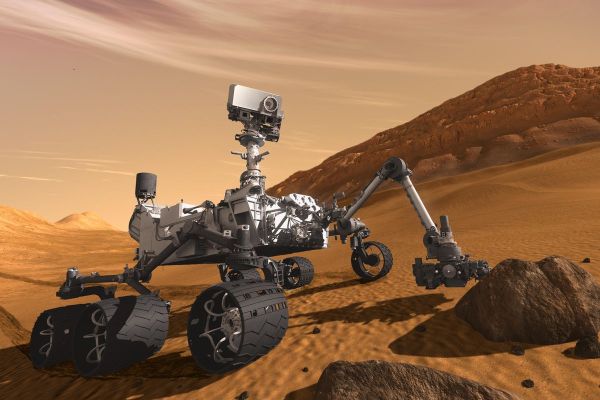A report released this week suggests that 50 flights into its five-flight schedule, the Mars helicopter might be starting to show its age. The report details a protracted communications outage Ingenuity’s flight controllers struggled with for six sols after flight 49 back in April. At first attributed to a “communications shadow” caused by the helicopter’s robotic buddy, Perseverance, moving behind a rocky outcrop and denying line of sight, things got a little dicey once the rover repositioned and there was still no joy. Since the helicopter has now graduated from “technology demonstration” to a full-fledged member of the team tasked with scouting locations for the rover while respecting the no-fly zone around it, it was essential to get it flying again. Several attempts to upload a flight plan failed with nothing but an acknowledgment signal from the helicopter, but a final attempt got the program uploaded and flight 50 was a complete if belated success. So that’s good, but the worrying news is that since Sol 685, the helicopter has been switching in and out of nighttime survival mode. What that portends is unclear, but no matter how amazing the engineering is, there’s only so much that can be asked on Ingenuity before something finally gives.
mars103 Articles
Simulated ET To Phone Home From Mars This Afternoon
In science fiction movies, communicating with aliens is easy. In real life, though, we think it will be tough. Today, you’ll get your chance to see how tough when a SETI project uses the European Space Agency’s ExoMars Trace Gas Orbiter to send a simulated alien message to the Earth. The transmission is scheduled to happen at 1900 UTC and, of course, the signal will take about 16 minutes to arrive here on planet Earth. You can see a video about the project, A Sign in Space, below.
You don’t need to receive the message yourself. That will be the job of observatories at the SETI Institute, the Green Bank Observatory, and the Italian National Institute for Astrophysics. They’ll make the signal available to everyone, and you can join others on Discord or work solo and submit your interpretation of the message.

There are a host of issues involved in alien communication. What communication medium will they use? How will they encode their message? Will the message even make sense? Imagine an engineer from 1910 trying to find, decode, and understand an ad on FM radio station 107.9. First, they’d have to find the signal. Then figure out FM modulation. Then they’d probably wonder what the phrase “smartphone” could possibly mean.
When [Frank Drake] created a test message to send to aliens via the Arecibo dish, almost no one could decode it unless they already knew how it worked. But even looking at the message in the accompanying image, you probably can only puzzle out some of it. Don’t forget; this message was created by another human.
If you want a foreshadowing of how hard this is, you can try decoding the bitstream yourself. Of course, that page assumes you already figured out that the stream of bits is, in fact, a stream of bits and that it should be set in an image pattern. You also have the advantage of knowing what the right answer looks like. It could easily become an extraterrestrial Rorschach test where you find patterns and meaning in every permutation of bits.
Speaking of the Drake message, it saddens us to think that Arecibo is gone. The closest we think we’ve come to intercepting alien messages is the Wow signal.
Continue reading “Simulated ET To Phone Home From Mars This Afternoon”
Giving A Tinge Of Color To The Mars Map Courtesy Of The UAE’s Hope Orbiter
Since the United Arab Emirates’ Hope (“Al-Amal”) orbiter made it safely into orbit around Mars on February 9, 2021, it’s been busy using its onboard instruments to measure everything it could about not only the planet’s atmosphere but also its surface and how both change seasonally. The first months of results of these detailed captures of Mars have now been released in the form of the full-color Mars Atlas website, and a pretty well made PDF version of the Atlas that can be downloaded from the website.
Although the Emirates Mars Mission is not the first to capture the surface or seasons of Mars — with the Mars Reconnaissance Orbiter (MRO)’s Context Camera (CTX) having gifted us the result of many thousands of captures in a massive monochrome mosaic of Mars’ surface — it’s good to remember that Hope is only just getting started. The current atlas is the result of about 3,000 captures from the Emirates eXploration Imager (EXI) multi-band camera (with better than 8 km spatial resolution), with new images in the pipeline.
Hope has transitioned from a low 1,072 km orbit to a higher, science orbit on March 29, which gives the orbiter a good view of the seasonal transitions on the Red Planet. Along with data from other current Mars orbiters, we should be able to piece together the most detailed atlas yet, even before more helicopters will zip along Mars’ surface.
NASA’s Curiosity Mars Rover Gets A Major Software Upgrade
Although the Curiosity rover has been well out of the reach of human hands since it touched down on Mars’ surface in 2012, this doesn’t mean that it isn’t getting constant upgrades. Via its communication link with Earth it receives regular firmware updates, with the most recent one being the largest one since 2016. In addition to code clean-up and small tweaks to message formats, this new change should make Curiosity both smarter and have its wheels last longer.
The former helps to avoid the long idle times between navigating, as unlike its younger sibling, Curiosity does not have the dedicated navigation computer for more autonomous driving. Although it won’t make the 11-year old rover as nimble as its sibling, it should shorten these pauses and allow for more navigating and science to be done. Finally, the change to reduce wear on the wheels is fairly simple, but should be rather effective: this affects the amount of steering that Curiosity needs to do while driving in an arc.
With these changes in place, Curiosity should be all ready to receive its newest sibling as it arrives in a few years along with even more Mars helicopters.
Hackaday Links: April 16, 2023
The dystopian future you’ve been expecting is here now, at least if you live in New York City, which unveiled a trio of technology solutions to the city’s crime woes this week. Surprisingly, the least terrifying one is “DigiDog,” which seems to be more or less an off-the-shelf Spot robot from Boston Dynamics. DigiDog’s job is to de-escalate hostage negotiation situations, and unarmed though it may be, we suspect that the mission will fail spectacularly if either the hostage or hostage-taker has seen Black Mirror. Also likely to terrify the public is the totally-not-a-Dalek-looking K5 Autonomous Security Robot, which is apparently already wandering around Times Square using AI and other buzzwords to snitch on people. And finally, there’s StarChase, which is based on an AR-15 lower receiver and shoots GPS trackers that stick to cars so they can be tracked remotely. We’re not sure about that last one either; besides the fact that it looks like a grenade launcher, the GPS tracker isn’t exactly covert. Plus it’s only attached with adhesive, so it seems easy enough to pop it off the target vehicle and throw it in a sewer, or even attach it to another car.
Hackaday Links: January 15, 2023
It looks like the Martian winter may have claimed another victim, with reports that Chinese ground controllers have lost contact with the Zhurong rover. The solar-powered rover was put into hibernation back in May 2022, thanks to a dust storm that kicked up a couple of months before the start of local winter. Controllers hoped that they would be able to reestablish contact with the machine once Spring rolled around in December, but the rover remains quiet. It may have suffered the same fate as Opportunity, which had its solar panels covered in dust after a planet-wide sandstorm and eventually gave up the ghost.
What’s worse, it seems like the Chinese are having trouble talking to the Tianwen-1 orbiter, too. There are reports that controllers can’t download data from the satellite, which is a pity because it could potentially be used to image the Zhurong landing site in Utopia Planitia to see what’s up. All this has to be taken with a grain of dust, of course, since the Chinese aren’t famously transparent with their space program. But here’s hoping that both the rover and the orbiter beat the odds and start doing science again soon.
Hackaday Links: December 25, 2022
Looks like it’s lights out on Mars for the InSight lander. The solar-powered lander’s last selfie, sent back in April, showed a thick layer of dust covering everything, including the large circular solar panels needed to power the craft. At the time, NASA warned that InSight would probably give up the ghost sometime before the end of the year, and it looks like InSight is sticking to that schedule. InSight sent back what might be its last picture recently, showing the SEIS seismic package deployed on the regolith alongside the failed HP3 “mole” experiment, which failed to burrow into the soil as planned. But one bad experiment does not a failed mission make — it was wildly successful at most everything it was sent there to do, including documenting the largest marsquake ever recorded. As it usually does, NASA has anthropomorphized InSight with bittersweet sentiments like “Don’t cry, I had a good life,” and we’re not quite sure how we feel about that. On the one hand, it kind of trivializes the engineering and scientific accomplishments of the mission, but then again, it seems to engage the public, so in the final rinse, it’s probably mostly harmless.















